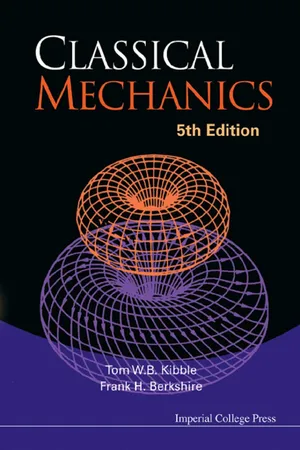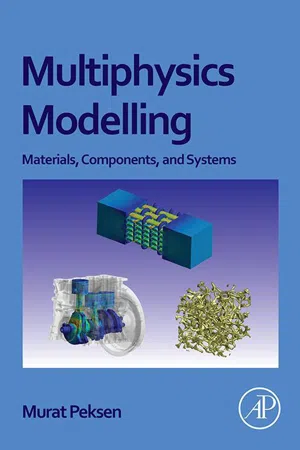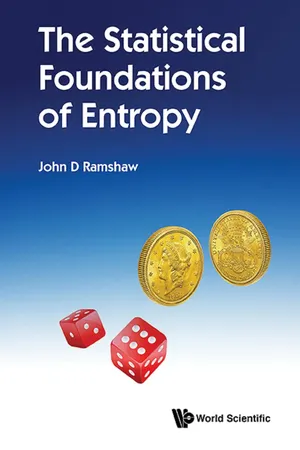Physics
Multiparticle System
A multiparticle system refers to a collection of multiple particles, such as atoms or subatomic particles, that interact with each other through various forces. In physics, the behavior and properties of multiparticle systems are studied to understand complex phenomena like phase transitions, magnetism, and superconductivity. The interactions and dynamics within multiparticle systems are crucial for comprehending the behavior of matter at different scales.
Written by Perlego with AI-assistance
Related key terms
Related key terms
1 of 4
Related key terms
1 of 3
3 Key excerpts on "Multiparticle System"
- eBook - ePub
- Tom W B Kibble, Frank H Berkshire(Authors)
- 2004(Publication Date)
- ICP(Publisher)
Chapter 8
Many-Body Systems
Any material object may be regarded as composed of a large number of small particles, small enough to be treated as essentially point-like, but still large enough to obey the laws of classical rather than quantum mechanics. These particles interact in complicated ways with each other and with the environment. However, as we shall see, if we are interested only in the motion of the object as a whole, many of these details are irrelevant.We shall consider in this chapter a general system of N particles labelled by an index i = 1, 2, . . . , N, interacting through two-body forces, and also subjected to external forces due to bodies outside the system. We denote the force on the ith particle due to the jth particle by Fij , and the external force on the ith particle by Fi . Then the equations of motion areHere, and throughout this chapter, the sum is over all particles of the system, j = 1, 2, . . . , N. Of course, there is no force on the ith particle due to itself, and so Fii = 0. The sum in this case is really over the other N − 1 particles.8.1Momentum; Centre-of-mass Motion
The position R of the centre of mass is defined, as in (7.2), byThe total momentum isIt is equal to the momentum of a particle of mass M located at the centre of mass.The rate of change of momentum, by (8.1), is Now the two-body forces must satisfy Newton’s third lawThus, for every term Fij in the double sum in (8.4), there is an equal and opposite term Fji . The terms therefore cancel in pairs and the double sum is zero. (Compare the discussion at the end of §1.3 for the three-particle case.)Hence we obtain the important result that the rate of change of momentum is equal to the sum of the external forces alone:In the special case of an isolated system of particles, acted on by no external forces, this yields the law of conservation of momentum,Let us now regard our system of particles as forming a composite body. If the body is isolated, then according to Newton’s first law it moves with uniform velocity. Thus we see that to maintain this law for composite bodies, we should define the position of such a body to mean the position of its centre of mass. Moreover, with this definition, Newton’s second law is just (8.6), provided that we interpret the force on the body in the obvious way to mean the sum of the external forces on all of its constituent particles, and the mass - eBook - ePub
Multiphysics Modeling
Materials, Components, and Systems
- Murat Peksen(Author)
- 2018(Publication Date)
- Academic Press(Publisher)
Chapter 5Multiphysics Modelling of Interactions in Systems
Abstract
Throughout this book, it has been elucidated that multiphysics modelling places great emphasis on the interactions between various systems. But first of all, how does a multiphysics analyst define a system? Is it possible to consider generally a system as an integrated set of elements that accomplish a defined objective? The current chapter gives a brief demonstration of typical basic interactions observed in fluid–fluid, solid–solid and fluid–solid systems. This will be followed by a large scale system analysis, comprising multiple components.Keywords
Multiphysics; modelling; system; interaction; FSI; CFD; FEMChapter Outline- 5.1 Fluid–Solid Interaction in Systems 142
- 5.2 Solid–Solid Interaction in Systems 145
- 5.3 Fluid–Fluid Interaction in Systems 148
- 5.4 3D Multiphysics Modelling of a System Architecture 150
- 5.4.1 Single Architecture Model and Assumptions 152
- References 156
Throughout this book, it has been elucidated that multiphysics modelling places great emphasis on the interactions between various systems. But first of all, how does a multiphysics analyst define a system? Is it possible to consider generally a system as an integrated set of elements that accomplish a defined objective?People engaged in different engineering disciplines have different perspectives of what a ‘system’ is. A software engineer often refers to an integrated set of computer codes as a ‘system’. Electrical engineers might refer to complex integrated circuits or an integrated set of electrical units as a ‘system’. A photographer may refer a system as his camera system, consisting of interchangeable lenses, the lens focusing mechanism, camera body, flash subsystem, electrical subsystem and power sources (Fig. 5.1 - eBook - ePub
- John D Ramshaw(Author)
- 2017(Publication Date)
- WSPC(Publisher)
Chapter 8
MANY-PARTICLE SYSTEMS
Many of the most interesting and important applications of entropy are to composite systems composed of simpler subsystems which either are, or can be thought of as, various types of particles. It is therefore convenient to refer to them as such, with the understanding that in some cases it may be appropriate to interpret the term “particle” in a generalized sense. The number of particles N in such systems is typically very large, so they are commonly referred to as “many-particle” systems, but it is well to keep in mind that the concept of entropy (and consequently much of the general formalism developed prior to Chapter 6 ) is equally applicable to both simple and composite systems of any type or number of subsystems, including particulate systems of small N. In addition to being of intrinsic interest in their own right, systems of small N provide the clearest illustration of the additional concepts required to apply the general formalism of entropy to systems of arbitrary N, including macroscopic thermodynamic systems containing N ~ 1023 particles.As stated in the Introduction, we restrict attention to pure systems composed of particles which are all of the same type or species. Since the particles are identical, they all possess the same set of single-particle states (i.e., states accessible to a single isolated particle). If the N particles in the system do not interact with one another then each particle simply occupies one of those single-particle states, and conversely each such state is either unoccupied or occupied by one or more particles. Thus the particles can be regarded as sharing the single-particle states, and the microstates of the N-particle system as a whole can be defined in terms of the single-particle states occupied by the individual particles. This description is valid for systems of noninteracting particles (i.e., ideal gases) in both classical and quantum mechanics. Moreover, it remains valid in classical mechanics even for systems of interacting particles, in which each particle continues to occupy the definite single-particle state (q, p) defined by its own coordinates q and momentum p
Index pages curate the most relevant extracts from our library of academic textbooks. They’ve been created using an in-house natural language model (NLM), each adding context and meaning to key research topics.
Explore more topic indexes
Explore more topic indexes
1 of 6
Explore more topic indexes
1 of 4


